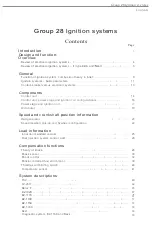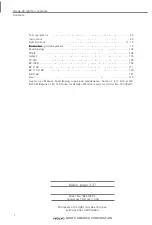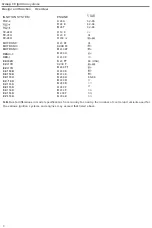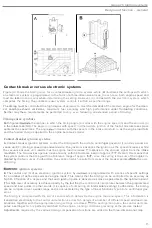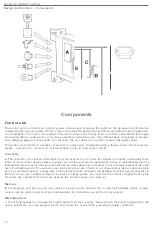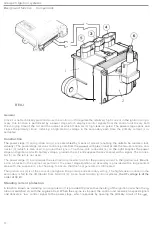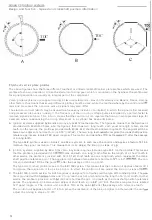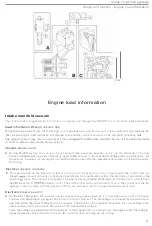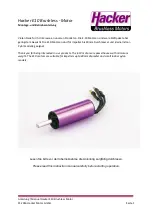
Group
28
Ignition
systems
Des
ig
n
and
funct
ion - General
Fig. 1
'Ho
t'
Fig. 2 'Cold'
•
Spark plugs
: Use of
the
correct
type
of spark
correctly
ins
ta
lled
and
replaced
at
th
e
re
commen
d
ed in
tervals
,
is
essential to
t
he satisfactory operation of
the
system.
Assuming the
engine to be in good co
ndition
,
ad
-
herence to these recommendations
ensure maximum
plug
life, making
the
component one o
f
the most re-
liable
the
ignition
sys
tem
.
In this
context,
may be of in
t
erest to
consi
der
some of
the
demands
impose
d
on
the
spark
plugs
and
to discuss a
number
of concep
t
s.
As the
means used
to
igni
te the
mixture in
the
combustion chamber,
the
spar
k
plug
in
it
ia
t
es
the
co
mb
us
t
ion
pro-
cess
.
The
plugs are designed
to
supply up
to
approx. 25 sparks per second
per
cylinder
at 6000 rlmin in a
4
-c
ylinder
e
ngine
,
from
a high-tension source
which,
in
the
case of
electronic
ig
nition
systems,
often operates at
over 30 kV
.
-
Spark
plugs must
be
capable of
withstanding
t
he extremely rapid
temperature and pressure
flu
c
t
u
ation
s
which
oc-
cur
in the
combustion chamber.
During the
combustion
process,
th
e
temperature rises at
in
terval
s
t
o
a value
of
perhaps
and the pressure to approx
.
60bar
(
870
psi)
.
Almost
immediately,
during the induction
stro
ke
,
the plug
co
mes
in contact
with the
cold,
un
co
mpressed fuel
l
air mixture
,
which
is
likely t
o
be
at the same temperature as
the
outside air
.
-
To
e
nsure
operation
within th
e
correct operating
temperature
range, spark plugs
are made
wit
h
different heat rat
·
i
ng
s (o
r
ranges) for different
engine
types
. I
f
the operating temperature
is
too
low
(i.e. below about
400
Q
C),
the
plug
w
i
l
l
rapidly
become coated
with
combustion
residues
.
This type
of
fouling weakens the spark and
ca
uses the
e
n
-
gine
t
o
miss. On the other
hand, if
the
opera
ti
ng
temperature
is
t
oo hig
h
(ove
r
approx
.
the
fuellair
mixture
may
be
ignited by the
i
n
candescen
t
plug surfaces,
initiating uncontrolled
combus
t
ion.
Every engine
manufacturer
s
p
ecifies
the
app
r
opriate
heat rat
ing
on
the
basis of parameters such as s
p
ecific engi
ne
output, probable
runn
i
ng
conditions and
clima
t
ic conditions.
-
A plug
with
a
heat
rat
ing
has a grea
t
er
thermal retention
capacity
and
conducts less heat
away
from the
co
m
-
bustion
chamber.
This
type is
normally
used on low-speed engines operating at
relatively
low
com
bustion tem
-
peratures. Plugs
of
type
are also
known
as 'hot' plugs and are provid
ed
with a
long insula
tor
nose as shown in
Fig
.
1
.
-
A
spark
a low heat rating has
a
lower
thermal
retention capacity and conduc
ts
a grea
t
e
r amount
o
f heat
away from
the
combus
t
ion chamber. This type
normally
used
on eng
in
es
with
high specific
outpu
t
s
operating at
re
la
t
ively
high
combustion
temperatures
.
Plugs
of
thi
s
typ
e a
re
also
kn
own
as
'co
ld'
plugs
and feature
a
short
in
·
sula
t
or
nose as
shown in
Fig
.
2.
-
Fitting
a
plug with the
recommended heat rating
will
ensure
that the
correct
working temperature
is
reached
quick
-
ly w
i
thout
t
he
of overhea
t
ing.
This
also assumes
that the
t
igh
t
ening
torque
within the
speci
fied limit
s,
since
the thermal
conductivity
will
be
dependent
on
th
e degree of contact be
tw
een
the
head
and plug
.
The
spark gap should also be checked; an
excessive
gap
will
cause
the
engi
n
e
to miss.
12



